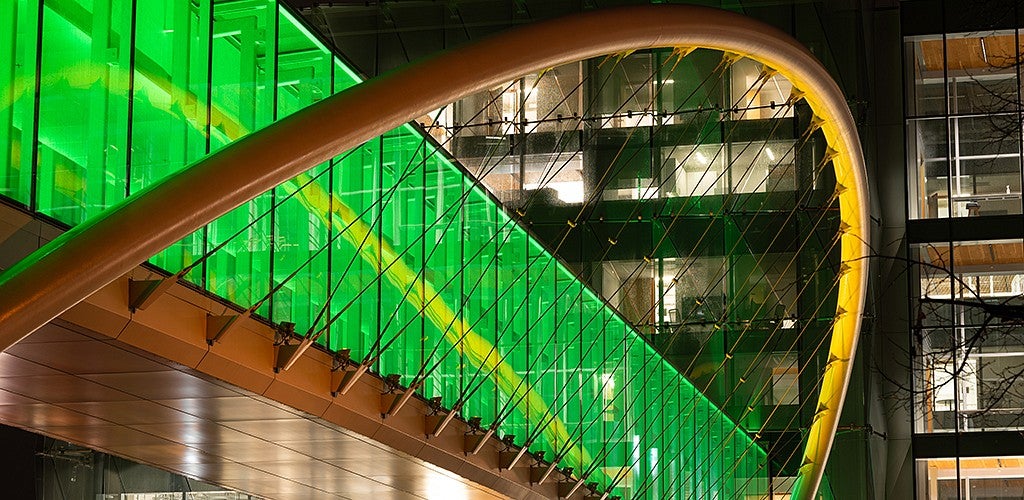
The first building of the University of Oregon’s Phil and Penny Knight Campus for Accelerating Scientific Impact is earning national acclaim for design.
The American Institute of Architects Committee on Architecture for Education named the Knight Campus as one of 11 exemplary "state-of-the-art designs of schools and learning centers" to receive its 2021 Education Facility Design Award. The project was one of six to receive the organization's award of excellence, which recognizes designs that meet "a host of criteria, including enhancing learning in classrooms; balancing function with aesthetics; establishing a connection with the environment; being respectful of the surrounding community; demonstrating high-level planning in the design process; and integrating sustainability in a holistic fashion," according to an AIA press release.
The building received special mention from the 2021 SEFA Lab of the Year awards. SEFA Lab of the Year recognizes outstanding laboratory buildings for their excellence, efficiency, safety, innovation, and impact on the future of laboratories.
In addition, the Knight Campus earned honors in the Society for College and University Planning’s (SCUP) 2021 Excellence Awards in the SCUP/AIA-CAE Excellence in Architecture category. The annual, juried honors recognize institutions for strategic, integrated planning that results in exemplary buildings and grounds, institutional success and careers that inspire.
The Knight Campus also earned the Jury Award from the Architizer A+ awards in the Architecture + Sustainability category.
In October 2021, the Knight Campus continued to receive accolades by earning a 2021 American Architecture Award from the Chicago Athenaeum Museum of Architecture and Design and the European Centre for Architecture Art Design and Urban Studies.
The UO celebrated the grand opening of the first building of the Knight Campus, a 165,000 square-foot, best-in-class facility, in December. Ennead Architects in New York and Bora Architects in Portland served as the lead architects for the first building, with Hoffman Construction as the general contractor.
“These awards honor the hard work of a diverse collection of creative minds, from faculty members to architects, who collaborated to produce an amazing facility. Because of the effectiveness of the team, the Knight Campus is a tribute to collaborative design that integrates form with function.”
— Darin Dehle, UO director of design and construction
“We are honored that the Phil and Penny Knight Campus for Accelerating Scientific Impact at the University of Oregon is being recognized by the AIA Education Facility Design Excellence Awards and the SCUP/AIA-CAE Excellence in Architecture Awards. These awards not only celebrate the building but acknowledge its transformative human-centered design that supports researchers as they advance the initiative’s mission to shorten the timeline between discovery, development, and deployment of innovations that will have positive societal impact.”
– Todd Schliemann FAIA and Jarrett Pelletier AIA, Ennead Architects
The design intent serves the impact cycle, a foundational idea of the Knight Campus best represented by the concepts of discovery, development, and deployment. The building is home to discovery at the lab bench; the development of biomedical devices and therapies; and the deployment of new technologies to the marketplace, where products, innovations, or cures impact people’s lives. The building’s design accelerates the impact cycle by efficiently bringing people together and encouraging collaboration.





